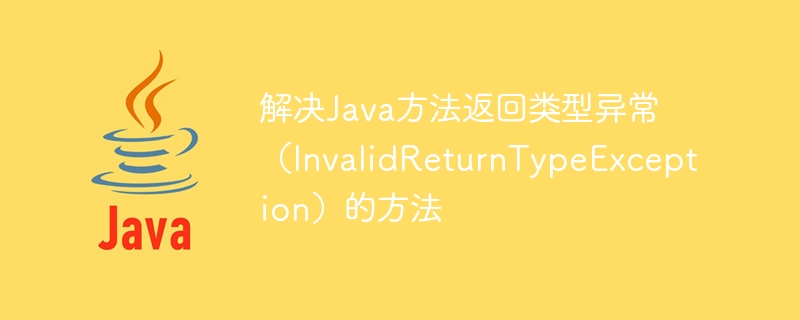Home >Java >javaTutorial >Methods to solve Java method return type exception (InvalidReturnTypeException)
Methods to solve Java method return type exception (InvalidReturnTypeException)
- 王林Original
- 2023-08-17 11:19:451704browse

Methods to solve Java method return type exception (InvalidReturnTypeException)
Introduction:
In Java programming, we often encounter various abnormal situations. One of them is InvalidReturnTypeException, which is a method return type exception. When we define a method, if the return value type in the method body is inconsistent with the return value type declared by the method, an InvalidReturnTypeException exception will be triggered. So how to solve this exception? This article will introduce several common workarounds, with corresponding code examples.
Method 1: Check the return value type declared by the method
First, we need to check whether the return value type declared by the method is correct. A method declaration refers to the return value type defined inside parentheses after the method name. For example, in the code below, we define a method called getStringLength, and the return value type should be int.
public int getStringLength(String str) {
// 方法体
}If a value of other types is mistakenly returned in the method body, an InvalidReturnTypeException exception will be triggered. Therefore, before checking the method body, we need to ensure that the return value type declared by the method is correct.
Method 2: Ensure that the return value of the method body is consistent with the declared return value type
If there is indeed a value that needs to be returned in the method body, then we need to ensure that the type of the value is consistent with the return value declared by the method The value types are consistent. For example, in the above code, if we want to return the length of the string, then the method body should return a value of type int. The following is a sample code:
public int getStringLength(String str) {
return str.length(); // 返回字符串的长度
}In this way, you can avoid the triggering of InvalidReturnTypeException exception.
Method 3: Dealing with the situation where the method body does not require a return value
Sometimes, the return value of a method is void, that is, there is no return value. In this case, we need to not return any value in the method body, otherwise an InvalidReturnTypeException will be triggered. For example, the following sample code defines a method that does not return a value:
public void printHelloWorld() {
System.out.println("Hello, World!");
}In this example, only a message is printed in the method body and no value is returned. If we add a return value by mistake, an InvalidReturnTypeException will be triggered.
Method 4: Use appropriate exception handling mechanism
When an InvalidReturnTypeException exception occurs, we can use an appropriate exception handling mechanism to handle it. Common processing methods include try-catch statements and throws keywords. In this way, once an InvalidReturnTypeException occurs, we can catch and handle it.
The following is a sample code that uses a try-catch statement to handle the InvalidReturnTypeException exception:
public int divide(int a, int b) {
try {
return a / b;
} catch (ArithmeticException e) {
// 处理除零异常
System.out.println("除数不能为 0!");
}
return 0;
}In the above code, we define a division method divide. If the divisor is 0, an ArithmeticException will be triggered. In the catch block, we can handle the exception, such as printing an error message.
Conclusion:
In Java programming, InvalidReturnTypeException is a common exception situation. This article introduces several methods to solve this exception, including checking the return value type of the method declaration, ensuring that the return value of the method body is consistent with the declared type, handling the situation where the method body does not require a return value, and using appropriate exception handling mechanisms.
By properly handling return type exceptions, we can write more robust and reliable Java programs.
Code sample:
public class ReturnTypeExample {
public int getStringLength(String str) {
return str.length();
}
public void printHelloWorld() {
System.out.println("Hello, World!");
}
public int divide(int a, int b) {
try {
return a / b;
} catch (ArithmeticException e) {
System.out.println("除数不能为 0!");
}
return 0;
}
public static void main(String[] args) {
ReturnTypeExample example = new ReturnTypeExample();
System.out.println(example.getStringLength("Hello"));
example.printHelloWorld();
System.out.println(example.divide(10, 0));
}
}Hope this article can be helpful in solving Java method return type exception (InvalidReturnTypeException). thanks for reading!
The above is the detailed content of Methods to solve Java method return type exception (InvalidReturnTypeException). For more information, please follow other related articles on the PHP Chinese website!

